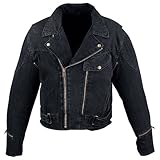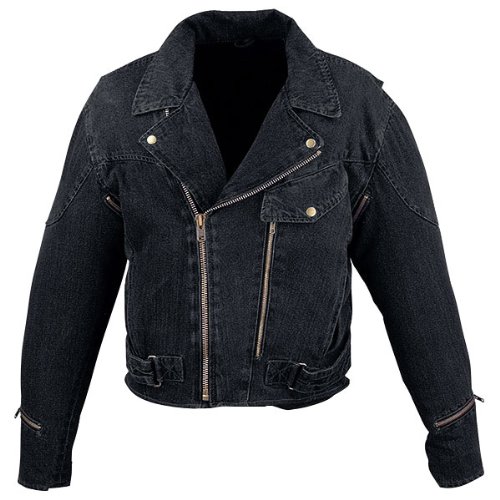| Denim Jacket - Mens Denim Motorcycle Jacket with Removable Armor MJ408 Black Denim Product Brand : Jafrum |

List Price : 

|
|
|
Denim
Denim Vest For Women
The word Denim originated from, "de Nimes", a little town in the south of France, where the cloth was originally woven and dyed indigo. In 1850, Levi Strauss started supplying gold miners with pants made of denim. The waist overalls Strauss created were so strong and durable they were nearly indestructible. These garments were nicknamed jeans.
The 1930's saw an explosion of western movies, with Cowboys clad in jeans. While Wwii, soldiers had sported jeans in their off duty time, taking the fad worldwide. After the war, new manufacturers of denim clothing entered the market, with Lee and Wrangler competitive with Levi for popularity. The youth of the 1950's loved jeans but the older crowd felt that it was a emblem of the rebel. This fuss assured the popularity of denim.
By the 1960's, the free to wear what you want decade, most everyone liked them. In the 1970's designers came out with the slim cut, boot cut, tight jean, baggy jean, hip-hugger, Capri length... The list goes on. Women established the denim jean as an necessary and diverse garment. Adding a pair of heels transformed jeans into ultra feminine and sexy attire. And denim wasn't just used for pants - skirts, dresses, jumpsuits, jackets, coats, vests and shirts became beloved in the 1980's.
The youth of the 1990's rebelled. Not to be caught dead in something their parents were wearing, they turned to other fabrics and styles - cargo pants, khakis and branded sportswear. While this time, it wasn't fashionable to shop in conventional jeans stores. The contradictory youth of the time, didn't give up jeans altogether. They found aged, authentic, vintage jeans, discovered in markets, and second-hand market as acceptable attire. Most likely something their parents once wore, years ago.
In the year 2000, denim jeans made a comeback with designers like Chanel, Chloe, Dior and Versace. Denim has been manufacture an appearance for more than 150 years. With every return, it demonstrates its enduring and imaginable versatility. Denim is genuine, straightforward and pure - it shows that "we are not trying to look good, we just do".
The White Shirt
The contemporary white collared cotton shirt was born in the 1920's when the Prince of Wales (later the Duke of Windsor) was seen anywhere in a shirt with soft turned down collars. The former decades of stated stiff, high, removable collars were gone for good. It was much great to appear to be able to afford a fresh clean shirt everyday rather than just a fresh clean collar. At this time, the white shirt went with enterprise suits, not casual wear.
In the 1950's the white shirt made its appearance as a button down style collared shirt. Women began wearing oversized men's white shirts with pedal pusher jeans and saddle back shoes. Even though trendsetters like Marlene Dietrich and Katharine Hepburn sported their crisp white shirts, women still tended to chose more feminine, fancy and printed blouses. In the 1970's the white collared shirt, which went well with the preppy skirts and pantsuits of the era, became a necessity in everyone's wardrobe.
With an plentifulness of styles to select from, the white shirt remains a wardrobe staple, you can wear with just about anything. Like denim, the plain white collared shirt says, "you don't have to look good, you just do."
The little Black Dress
Always simple, elegant, sexy and of policy black - the little black dress is an necessary item for all ladies. A must have in every closet.
The debut of the term "the little black dress" was by Coco Chanel, in a 1920's Vogue magazine. Black was previously reserved for funerals and periods of mourning. Truly straightforward and sexy, Chanel's fabricate was a sleeveless sheath cut just above the knee. Chanel summed up the fashion of the little black dress when she stated, "Luxury must be comfortable, otherwise it is not luxury."
The little black dress endured straight through the 1940's becoming the little wasp waist dresses of the 1950's. The sublime knew a little black dress could be exquisite for most occasions. Audrey Hepburn in the 1961 film, "Breakfast at Tiffany's" wore a sleeveless Givenchy shift. She continued wearing the same shift to cocktails parties and even on a visit to Sing Sing... Looking exquisite on every occasion.
The little black dress is all the time sexy, whether it is a straightforward sleeveless satin sheath or a slip dress. Ordinarily slimming, when selecting your little black dress, do select the silhouettes that most flatter your body type. It can be a chemise from the 1920's or a sheath from the 1960's. Look for straightforward tailoring with fine details and luxurious fabrics. Again, "The little Black Dress" says, "you don't have to look good, you just do."
excellent Vintage Clothing everybody Can Wear No URLSee Also : Cheap Dimond Rings 7ft pool table two way baby monitors










(0) Comments
Leave a Response